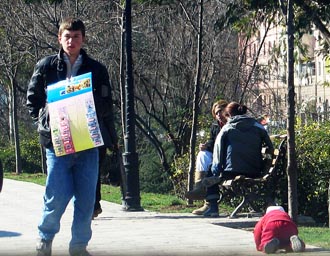Study Recognizes Plight of Albanian Street Children
Half of the children who work on the streets of Albania's capital experience physical abuse, according to a recent World Vision study facilitated by Tulane University international public health researcher Tonya Thurman.

An Albanian street child holds something for sale on the street. To his right crawls a 1-year-old Roma child, whose parents left him on the street to beg. (Photo by Gerta Yzeiraj Hagen, World Vision Albania)
Thurman, a research assistant professor in the Department of International Health and Development in the Tulane School of Public Health and Tropical Medicine, trained local researchers to interview street children between 10 and 17 years old in Tirana, Albania, about their backgrounds, family situation, education and daily lives.
After the end of communist rule in Albania in 1992, amid economic collapse and social unrest, Tirana experienced fast population growth when people from rural areas moved to the capital to find a better life. Family poverty is one of the main conditions that result in children begging or working on the street.
Children who spend their days begging, selling items or cleaning cars are not necessarily homeless or out of school, the study found. Survey design and interviewer technique are crucial to building rapport with street children, Thurman says.
"There are a number of different interviewer techniques to make children comfortable. I prepare the interviewers to be able to respond in a neutral but yet supportive manner when the children disclose their circumstances, teach them how to avoid inappropriate relationships, and how to control their response if children say something shocking. We've been building the capacity of World Vision staff to collect this data," Thurman elaborates.
Once trained, the researchers spoke with 293 street children, the majority of whom were males under the age of 14. Most (80 percent) of the children lived with both parents. Many (59 percent) attend school, although they faced difficulties with schoolwork, had poor attendance, reported feeling stigmatized by classmates and teachers and were at greater risk for dropping out.
The survey is part of World Vision's Children in Crisis Laboratory of Learning global initiative implemented with the help of Tulane University. Thurman and Nancy Mock, associate professor of international health and development, serve as co-principal investigators. Consultant Lisa Johnston, who is an expert in the respondent-driven sampling method used to recruit participants, and Tulane doctoral student Bridget Lavin also participated in the survey.
World Vision staff and Thurman will develop a program to address the children's needs based on the data.
"I love that the survey data will result in a program that meets the needs of these children. Without assistance, street children may not be able to reach their full potential because of the risks of working on the street," Thurman says.
Thurman anticipates being able to begin monitoring and evaluating the effectiveness of the proposed program by October. In July, Thurman and the World Vision team will begin a similar process among street children in India.
